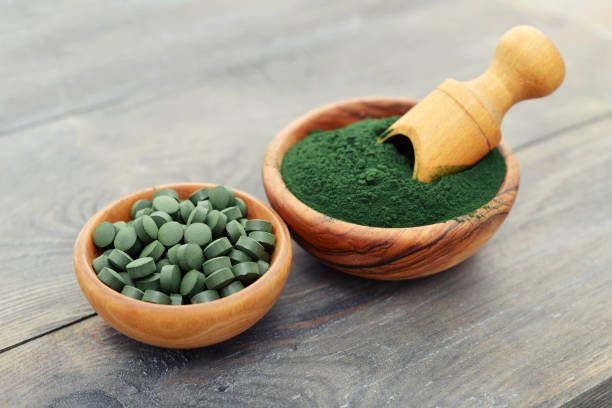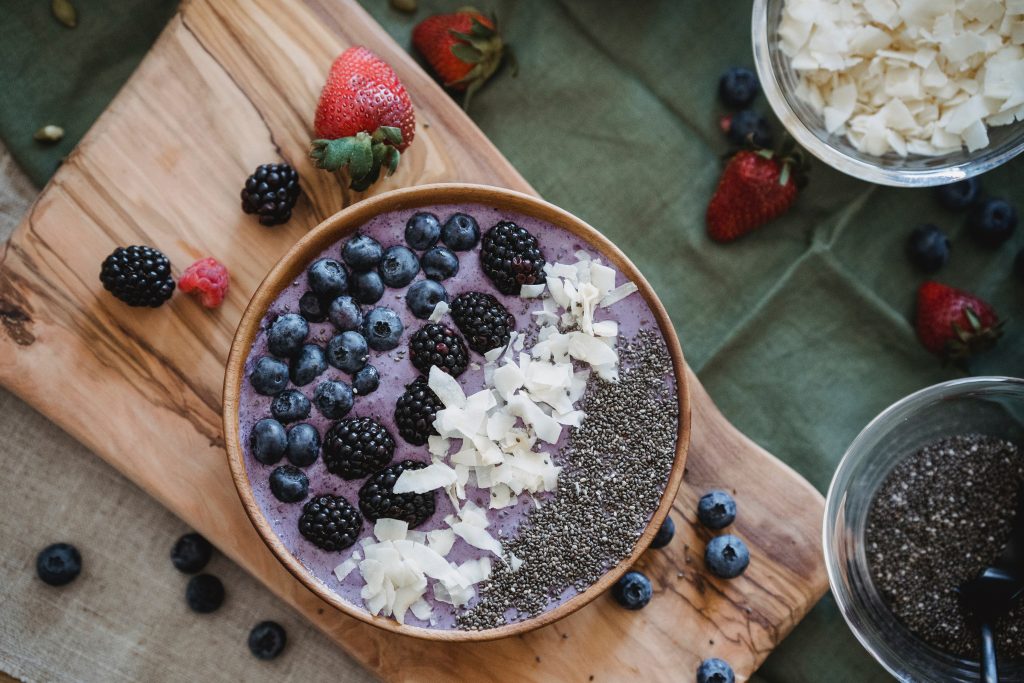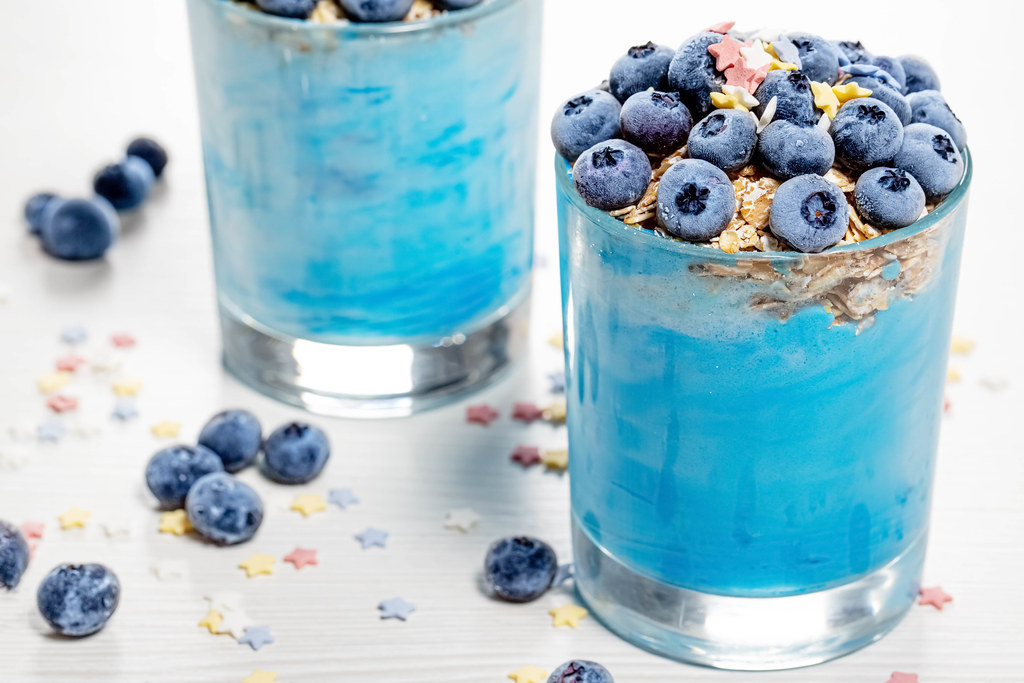Blue Spirulina is a term that comes up more often in the fields of nutrition, wellness, sports, and everyday life. Indeed, this is one of the main components of these healthy pastel meal colors we can see on Instagram. However, this new form of spirulina has raised many questions and queries.
- Is there a difference between spirulina and blue spirulina?
- What are the heath benefits of blue spirulina?
- Blue spirulina vs green, which one is better for me?
- What does spirulina taste like?
Discover all you need to know about this blue-green algae superfood, from its strong benefits, dosage, and possible side effects to the precaution to take.
What is Spirulina?

Spirulina is a microalga, more precisely, a cyanobacteria (Arthrospira Platensis) of spiral shape. The high concentration of chlorophyll gives it its green-blue color. Hence, it is also commonly named “green spirulina.” This edible microalgae appeared more than 3.5 billion years ago and was already harvested on the surface of lakes by the Aztecs and the Kanembous living in Chad. They dried it and consumed it in patties. Now spirulina is cultivated in farms because of its nutritional and therapeutic virtues. Spirulina owes its worldwide success to the many virtues it possesses. Indeed, its nutritional composition with numerous antioxidants and nutrients makes it a superfood of the first choice, with multiple benefits for the body!
What is blue spirulina?
Blue spiruina is a concentrated extract of a blue pigment from the blue-green alga Spirulina Arthrospira Platensis, called phycocyanin. The bright blue color of its powder comes from its intense pigment found only in blue-green algae. This alga is present in freshwater lakes and many artificial reservoirs built as an alternative.
Blue spirulina vs green
Blue spirulina and green spirulina come both from blue-green algae. However, there are differences between them. Indeed, green spirulina is the entire species of algae. Whereas the other is only the phycocyanin pigment extracted from the blue-green algae.
Then, in terms of taste, green spirulina has a salty, fishy taste, while the blue one has a milder flavor. Furthermore, the first one has a blue-green color while second one has a very intense blue color.
Another essential difference between these two types of blue-green algae is that blue spirulina is the only natural blue pigment certified as a food additive. That is why we see people frequently prepare sweet or savory meals with it. It is a healthy and natural alternative to artificial colors.
Nevertheless, as far as health benefits are concerned, both forms offer exceptional nutritional values! Both have a high content of vitamins, minerals, and proteins essential to improve our health. Finally, blue spirulina is more expensive than green spirulina. Indeed, it requires a more complex extraction process.
Blue spirulina benefits
Here you can find the benefits that blue spirulina brings to your health:
Reduce stress
This blue superfood is considered an “essential” amino acid. Indeed, this alga contains a lot of tryptophan which supports the production of serotonin and promotes relaxation. Therefore, it is beneficial for people suffering from anxiety.
Help build muscles and repair damaged cells/tissues
Pure blue spirulina is an excellent source of protein. Indeed, its protein content is much higher than red meat or tuna (60% per 100 grams of spirulina). It helps to maintain cellular metabolism and build muscle. But also to repair cells or damaged tissues.
Boost immune system & reduce allergy
Several studies suggest that the blue-algae would reduce the production of histamine in the body and soothe the sensations of nasal inflammation, thus reducing the risks of allergies. In addition, its anti-inflammatory properties would reduce the risk of heart disease and even have anti-cancer properties.
In addition, blue spirulina supplements have good antioxidant properties that can combat oxidative stress and activate a more effective immune system response.
Fight anemia & deficiency
Anemia is a health problem that results in a low amount of red blood cells in the body. This low level of red blood cells does not correctly deliver oxygen to the body parts. Spirulina contains a high level of B vitamins, one of the building blocks of red blood cells, along with iron and folate. Blue-green algae contain vitamins B1, B2, B3, and B12. Therefore, using blue spirulina as a dietary supplement to obtain a vitamin B intake can be a solution for people suffering from anemia or a deficiency.
Stimulates the organism and helps to lose weight
The blue-algae extract is low in calories and high in nutrients. It is, therefore, the slimming ally for people who want to lose weight while having a high nutrient intake. In addition, its high percentage of protein reduces the feeling of hunger while increasing energy.
What does blue spirulina taste like?

Blue spirulina is only an extract of blue-green algae. Hence, blue spirulina taste is much milder and more neutral. Whereas green spirulina has a strong salty taste. The lack of taste of blue spirulina, makes it easy to add to all your daily meals without compromising on nutritional value.
On top of that, its intense blue color offers an aesthetically pleasing result to your regular meals.
How to incorporate blue spirulina into my diet?

Blue Spirulina is easy to incorporate into your diet, especially in powder form. You can mix it into your water, juice, smoothies, or lattes. There are many creative ways to add it to your meals.
How to store spirulina after opening its packaging?
Blue spirulina keeps very well. Moreover, as it does not contain any oil, its benefits do not alter, and there is no risk that it smells over time. You just have to close the package and place it in a fresh and dry place to preserve your product.
Spirulina side effects
Each individual has a different digestive process and stomach. It is therefore important to consider that if a meal based on spirulina works well for some, it will not be the same for others. Even if blue spirulina has many benefits for your health, it can cause, in some cases, allergies or indigestion.
Here are the symptoms of intolerance to watch out for, especially if it is the first time you consume spirulina:
- Abdominal/stomach pain
- Vomiting
- Diarrhea
- Insomnia
- Nausea
If you experience any symptoms, please consider seeking the advice of a specialist or dietician.
If you suffer from any of the following conditions, avoid consuming blue spirulina:
- Multiple sclerosis
- Rheumatoid arthritis
- Phenylketonuria
- Kidney stones
- Allergy to seafood
Moreover, don’t consume blue spirulina during pregnancy or breastfeeding.Therefore, be sure to take the time to research the companies that offer it for sale. Ensure that the brand is reliable and that the product is from a clean source.
Conclusion
The high nutritional density of blue-green algae and its antioxidant properties make it a first-choice health ally. Whether it is the traditional spirulina (green spirulina) or the blue one, both are beneficial for our health and well-being. Moreover, blue spirulina is available in many forms: tablets, capsules, or powder. No doubt that you will find the type of format that will suit you best! However, it is essential to check its quality before consumption. Favor an ethically produced blue spirulina.
This article is only a guide, not a replacement for medical advice. Consult your healthcare professional before making any health-related decisions.


